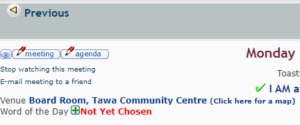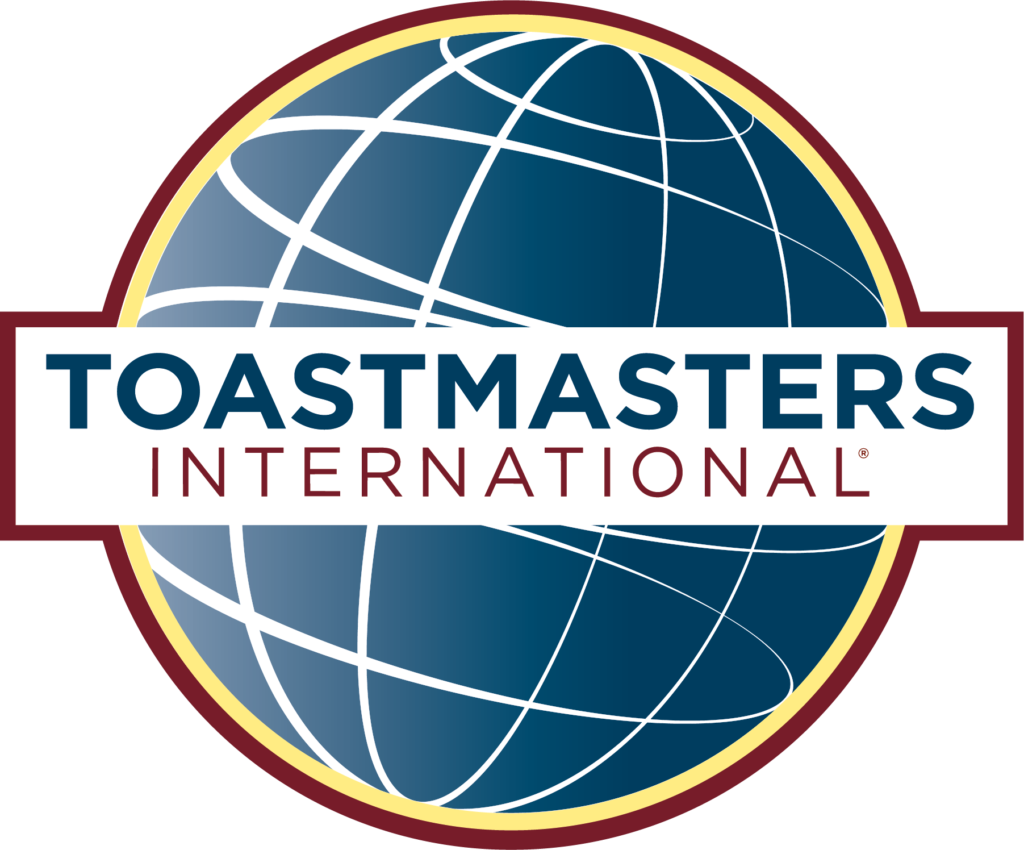Answers to Frequently Asked Questions
Click on the “+” sign to view
Toastmasters is a non-profit educational organisation that teaches public speaking through a worldwide network of clubs. Toastmasters International is headquartered in Colorado, USA. Membership exceeds 364,000 people. Since 1924, Toastmasters has helped people from diverse backgrounds become more confident speakers, communicators and leaders.
It costs $120 to join Tawa Toastmasters for 6 months.
- You will learn how to speak confidently in front of the public. This is great for work, weddings and funerals.
- The nervousness before a speech is the same feeling you get before a job interview, something familiar can be controlled.
- You will make friends with the members in our club. A sense of belonging.
- You will have fun. We have dinners and special meetings such as a funny hat meeting.
- Be amazed and inspired by speeches.
- Great networking opportunity
- We have yearly conferences where you will hear the best speakers in the world.
Our vision is to improve our Speaking, Listening and Thinking. We do this by:
Speaking: Improve by speaking to our club members
Listening: Improve by evaluating a speech. You have to really listen to evaluate a speech
Thinking: Improve by impromptu speaking. You answer a Table Topic question for 2 minutes
We learn in moments of enjoyment. We have Christmas and Mid-Year dinners. We have guest speakers come to our club. We have joint meetings with other clubs.
Everyone in our club was a beginner once. We are here to support you. Nervousness will diminish or disappear with practice. For your first speech we appoint an experienced member to help you.
Yes. You are most welcome to join us. Contact us to confirm a meeting is on.
We meet on the 2nd and 4th Mondays of the month. We start at 7:00pm. Arrive 10 minutes early. The meeting lasts for two hours.
We meet in the Board room at Tawa Community Centre. The address is 5 Cambridge Street Tawa Wellington.

After getting comfortable with some of the smaller meeting roles we will give you a slot in a meeting to do your first speech. This is called the Ice Breaker speech. This gives you the opportunity to introduce yourself to the club.
This is our meeting scheduler. It shows when meetings occur. It allocates meeting roles to our members. Easy-Speak sends an email to members 2 weeks before a meeting. This gives time to prepare for a meeting?
Pathways is a Toastmasters education program. When starting you take an online assessment to determine your goals. Then you get a recommendation to do a path. There are 11 paths. One of the paths is Presentation Mastery where you can learn the following
- Deliver Social Speeches
- Using Presentation Software
- Connect with Storytelling
- Creating Effective Visual Aids
- Using Descriptive Language
- Connect with Your Audience
- Make Connections Through Networking
- Focus on the Positive
- Inspire Your Audience
- Prepare for an Interview
- Understanding Vocal Variety
- Know Your Sense of Humor
An explanation of meeting roles
Click on the “+” sign to view
Ah Counter
The Ah Counter listens to the club members and notes any unnecessary filler words such as:
- Anyway
- You know
- So
- Um
- Like
- Totally
- Basically
- Seriously
- Actually
- Uh
- Um
- Err
- Well
Start of the meeting
The Ah Counter introduces the role at the start of a meeting, emphasising to club members the importance of avoiding filler words and encouraging them to strive for clarity in their speech.
End of the meeting
At the end of the meeting, the Ah Counter announces the results. For example:
- Tony used “um” 3 times during his speech.
- Mark used “ah” twice during his table topic.
- Mercy said “you know” once when introducing a speaker.
Final thoughts
This role is challenging as it requires concentration throughout the entire meeting. When announcing the results, it’s essential to be cautious not to use any filler words yourself. It’s always amusing when a club member criticises others for saying “ums” and “ahs” while inadvertently using those very filler words during their feedback.
Aim
The aim of the Ah Counter is to reduce and eliminate filler words from our speaking.
Evaluator
Provides feedback to a speech. This is vital as improvement in speaking requires constructive feedback. Two evaluations are provided. They are voice and written.
Voice
When doing a voice evaluation, a good rule of thumb is to evaluate using this procedure:
Commend: Mention something good about the speech
Recommend: Mention something not so good and needs working on
Commend: Mention something good about the speech.
Example of a Voice evaluation
Commend
I really liked the speech given by Tony on the funeral business. It was very funny. Good vocal variety and hand gestures
Recommend
My recommendation for Tony is to move around more. Use the stage. This will put energy into the speech.
Commend
An excellent speech. It is so good I challenge Tony to enter the Humorous contest with this speech.
Written
We also give written evaluations for a speech. The speaker should give you the evaluation form for the speech. If you don’t have an evaluation form than ask the speaker for the pathways speech assignment. The pathways evaluation form can be found by clicking on the menu item “Resources” on this website.
General Evaluator
The General Evaluator does the following:
1. Provide feedback for the Meeting Manager
Did the meeting start on time? Did the meeting finish on time? Was the meeting well run? Was an agenda provided.
2. Provide feedback for the Table Topics Master
Did the Table Topics Master explain how Table Topics works? Were the Table Topic questions easy to answer by new members and challenging for the experienced members?
3. Provide feedback for the Grammarian
Was the Word of the Day a good word for the club members to learn? Did the Grammarian point out any good and poor Grammar? Was a listening challenge done?
4. Provide feedback for the Ah Counter
Did the Ah Counter provide club members the AH’s and Umms that occurred in their speaking?
5. Provide feedback for the Timer
Did the Timer provide the appropriate Green, Amber and Red lights for members? Did the Timer advise which speech went over time?
6. Provide feedback for the Evaluators
Did the Evaluators provide constructive feedback for the members speaking
7. Point out any problems that need to be fixed
If members have mobile phones disturbing the meeting this should be pointed out by the General Evaluator
8. Award trophies for Best Contribution and Best Evaluator
The Best Contribution to the meeting and the Best Evaluator are awarded trophies by the General Evaluator.
Grammarian
The Grammarian performs the following roles:
- Word of the Day
- Unusual Grammar
- Poor Grammar
- Listening Challenge
Word of the Day
Here is an example of the Word of the Day recently presented at our club:
Maya introduced the Word of the Day – “Sanguine”. Maya explained how “Sanguine” is pronounced and also clarified its meaning. She printed “Sanguine” on two A4 sheets of paper. Maya taped one copy to the lectern and the other to the back of the room. We then had the challenge of incorporating “Sanguine” into our speeches.
Purpose of the word of the day
The purpose of the “Word of the Day” is to expand our vocabulary. Easy-Speak has an excellent Word of the Day feature on the Next Meeting screen:

Click on  to start Word of the Day
to start Word of the Day
Unusual Grammar
If the following is said during a meeting:
“If your daddy’s name is Jim and if Jim swims and if Jim’s slim, the perfect Christmas gift for him is a set of Slim Jim Swim Fins.”
This tongue twister should be highlighted by the Grammarian.
Poor Grammar
Mark said he will put a Jalapeño on his bread. Jalapeño was pronounced with a “J” sound, which is incorrect. It should be pronounced with an “H” sound – “Halapeño”. Jalapeño is a Mexican-Spanish word.
It is important to be tactful when addressing poor grammar and mispronunciations.
Listening Challenge
This test checks if club members are attentive. If the following statements are made:
Maya said, “A Mentor helps new members in our club.”
Tony said, “She was starting to lose her memory.”
Then ask the audience:
- Who said, “A Mentor helps new members in our club?”
- Who said, “She was starting to lose her memory?”
Listening is essential for effective communication.
Start of the meeting
Introduce the Word of the Day and ensure it is visible so members are reminded to use it in their speeches. Mention that unusual and poor grammar will be noted, and announce that a listening challenge will be conducted.
End of the meeting
Announce who used the Word of the Day in their speeches. For example:
Jeremy used “Sanguine” twice.
Paul used “Sanguine” three times.
Highlight instances of unusual and poor grammar, then conduct the listening challenge.
Meeting Manager
The Meeting Manager runs the meeting. Also known as the Chairperson or Toastmaster.
Before the meeting
Decide on a meeting theme and put it into Easy-Speak.

If needed put club members to roles. Contact the Vice President Education about this. Then make sure members doing a speech have at least 1 week to prepare a speech.
Before the meeting starts and the same day
Print out the agenda from Easy-Speak. Enough for the club members and a few more for guests.
During the meeting
- Start the meeting on time.
- Welcome members and guests.
- Ask that phones are turned off.
- Announce changes to the agenda.
- Introduce the Meeting Theme.
- Have interesting tidbits as fillers between items in the agenda.
- Introduce each person. Start the applause and shake hands.
- Bring the members back from the meal break.
- Finish on time
Speaker
Delivers a prepared speech to the audience.
Ice Breaker
The first speech at our club is the Ice Breaker speech. Introduce yourself to the club. Where did you come from? What are you doing now? What are your hopes for the future? Tell us about yourself. Notes can be used. The speech is 4 to 6 minutes long.
Competition Speeches
The club runs competitions during the year to determine the best speakers in the club. These are the Humorous, Table Topics, International and Evaluation speech contests.
Pathways
Pathways is a Toastmasters education program. When you first start you take an online assessment to determine your goals. Then you get a recommendation to do a path. You have to do many speeches to complete a path.
Work Speech
If you have to do a speech at work then practice your speech in front of the club members. We will evaluate your speech and help make the speech better.
Educational Speeches
Occasionally the experienced members of the club will do an educational speech to help new members.
Controversial speeches
Please don’t do a controversial speech. Club harmony is important. Tawa is a religious town. We have a church on every corner on the Main Road. Please don’t do a speech denigrating the religious faith of many of our members.
Table Topics Evaluators
Evaluates the Table Topics speeches. Club members do a two-minute impromptu speech. The Table Topics Evaluators provide constructive feedback. A good rule of thumb when evaluating a speech is to follow the CRC method. This is
Commend: Say something good about the speech
Recommend: Say something that needs to be improved
Commend: Say something good about the speech.
Example of a Table Topic Evaluation
Commend
I really like the Table Topic given by Mercy on the country of Samoa. Good vocal variety and hand gestures
Recommend
My recommendation for Mercy is to speak some Samoan words. Bring the Samoan culture alive.
Commend
An excellent Table Topic. Gave us insight to her home country.
Odds and Evens Evaluators
At our club we have two people evaluating the Table Topics speeches. It is really difficult for one person to evaluate all of the people doing Table Topics. So, one person evaluates the odd people speaking. This is the 1st, 3rd, 5th… speakers. The other person evaluates the even speakers, this is the 2nd, 4th, 6th… speakers.
Best Table Topic Speaker
The Table Topics evaluators award a trophy to the best speaker.
Table Topics Master
The Table Topics Master asks a question. A Club member answers by speaking for two minutes.Table Topics is speaking without prior preparation. Impromptu speaking.
Before the meeting
Contact the Meeting Manager to see if there is a theme to the meeting. If so, prepare topics about the theme. e.g.,
The theme is Winter
- Do you like winter?
- Have you been skiing before?
- What is your favorite comfort food?
Holiday
If there is no theme then is the meeting close to a holiday like Anzac Day?
- What does Anzac Day mean to your family?
- Were your Grandparents involved in war?
- What are your thoughts on Hiroshima?
Google
Look at “Toastmasters Table Topics” to get topics to use.
Introducing Table Topics
The Table Topics Master starts with an introduction similar to this:
“The purpose of Table Topics is to speak off the cuff. Impromptu speaking. In our life we are more likely to do impromptu speaking then do a prepared speech. The green lights come on at 1 minute. This means you are half way in your speech, keep speaking. The yellow light comes on at 1 minute 30, wrap it up. The Red Light comes on at 2 minutes, this means finish”
Types of Members
There are 3 types of members:
Guests: Ask them to talk about themselves
New Members: Give them easy Table Topics
Established Members: Give them hard Table Topics
Example of Table Topics
The Table Topics Master calls Jeremy to the front and asks “What does Anzac Day mean to your family? Jeremy has to give a speech lasting 2 minutes. Perhaps his Granddad was in WW2 or Jeremy talks about getting up early for the Dawn Parade.
Have enough Table Topics so everyone in the audience can speak.
Table Topics Speaker
Speaks for two minutes. This is impromptu speaking. Speaking without prior preparation. This is the hardest speech in Toastmasters. Even the most experienced Toastmaster gets flustered when doing this role. Common techniques for answering a Table Topic are:
- Past, Present and Future
- Local, National, International
Past, Present and Future
Past, Present and Future is answering a table topic that has time in the question. For example, Maya is asked “How do you celebrate Christmas”
Past:
I was bought up in Switzerland. We celebrate Christmas on the 24th December at night time. We have a Christmas tree and presents and a nice dinner.
Present:
I moved to New Zealand and we celebrate Christmas the New Zealand way. A BBQ outside at lunch time. Lots of food with the family.
Future:
In the future we will spend Christmas on a spaceship. We are floating in space. Santa is wearing astronaut clothing with a red hat.
Local, National and Future
Local, National and Future is answering a table topic that has geography in the question. For example, Tony is asked “Where is the best place to go Fishing?”
Local:
I go fishing every weekend. I know all of the best places to fish in Wellington. If I told you where the best fishing sites are I would have to shoot you. My fishing sites are secret.
National:
I understand the best fishing place in New Zealand is The Chatham Islands. It’s so isolated. Lots of fish.
International:
The best fishing places are the most isolated. Antarctica is the best fishing place in the world. For months of the year, it is cold and the seas are rough. Unable to fish. In the summer time there is an abundance of fish.
Timer
One of the skills Toastmaster’s practice is expressing a thought within a specific time. The Timer is responsible for monitoring the time of each person speaking. We use timing equipment that displays a Green light, an Amber light and a Red light.
During Table Topics Paul was asked “Tell us about the coronavirus response in New Zealand”. Paul started speaking. The Green light came on at 1 minute, this means half way in the speech. The Amber light came on at 1 minute and 30 seconds, this means wrap up the speech. The Red light came on at 2 minutes, finish the speech.
Before the meeting
Check the timing equipment are working and put them where they are visible to all speakers.
During the meeting
The agenda has the timings for the Green, Amber and Red lights for each role. If any speaker goes over their allocated time by more than 30 seconds then hit the bell – “bing”, “bing”, “bing”.
End of the meeting
Mention the people who spoke under or over the allocated time in the agenda
